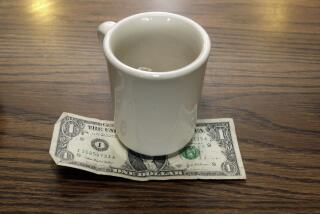Priest, Doctor Team Up to Create Wine Success
- Share via
BROOKFIELD, Conn. — So what happened when the gynecologist and the Franciscan friar went to the cellar to make some wine?
Something just short of a miracle, they both will tell you.
The gynecologist, 62-year-old Dr. Paul DiGrazia, also happens to be an oenologist, a medal-winning winemaker who brings the science of chemistry and the latest technology to the ancient art that Noah practiced.
The Franciscan, 41-year-old Father Gerald Waterman, grew up in “The Hollow,” the Italian section of nearby Bridgeport, where his maternal grandfather and uncle made wine in the basement.
The friar teamed up with the gynecologist after some wine Waterman concocted in the cellar of St. Hyacinth’s Seminary in Granby, Mass., proved a big hit at last spring’s fund-raising garden party.
Waterman, who was then director of vocations at the seminary, had taken up where his grandfather left off when a neighbor brought in some grapes from a nearby farm.
The crowds lining up at his wine tasting booth so impressed the superior of his province, which is headquartered just outside Baltimore, that he asked the priest to explore the possibilities of marketing a wine to help finance the care of elderly Franciscans and the education of novices.
The friar sought the advice of the gynecologist, who ran the successful DiGrazia Vineyards, growing grapes on nearly 100 acres and producing wines elegant enough to be served at the White House.
Instead of just sharing know-how, DiGrazia enthusiastically offered to join the friar in devising and bottling several new varieties of wine that would be marketed under the Conventual Franciscan Friars label.
The Conventual Franciscans, a branch of the order founded by St. Francis in 1209, are distinguished by their black robes.
“In Europe, our friars have been making wine since the Middle Ages, but this was the first such venture for our province,” Waterman said while monitoring the solemn procession of bottles toward the corking machine.
DiGrazia, who continues a busy gynecological practice, began growing grapes and making wine as a family hobby in 1978. He became a serious vintner in 1984 when two of his wines won gold medals at an international wine show in Lancaster, Pa.
Now, with the help of his wife, Barbara, and son, Paul Jr., he markets 18 varieties a year and has successfully experimented with non-sulfite wines.
*
The priest, who has been a missionary in Ghana and Costa Rica, a seminary professor and a worker in inner-city parishes, set about practicing every phase of modern viticulture--from picking and pressing the grapes to designing the labels on his computer. These depict the tiled roofs of the Basilica of St. Francis at Assisi as viewed from the arched window of a monk’s cell.
Their first vintage hit area wine retailers early in December and was dubbed “a near miracle” by the collaborators when all 1,300 cases sold out two days before Christmas. Three varieties are being marketed to benefit the order:
* “Beatific Vision,” a blush wine with a natural raspberry flavor.
* “Poverello,” meaning “poor man” in Italian, invokes the lifestyle St. Francis prescribed for his friars, a semi-dry white table wine.
* “Terra Virgo,” meaning virgin Earth, a dessert wine made from “some very complex secrets,” which the friar declines to divulge beyond noting that it is fortified with 90-proof brandy, aged in oak casks and “blended with angelica and other spices and some orange extract to give a faint suggestion of Grand Marnier.”
“In many cultures and religions, wine is associated with celebration, sacrifice and healing,” said the friar, who in medieval days would have rated the important monastic title of cellarer. “We in the priesthood look upon the world as the Lord’s vineyard. Now, I tell my colleagues I literally am laboring in the Lord’s vineyard.”
More to Read
Eat your way across L.A.
Get our weekly Tasting Notes newsletter for reviews, news and more.
You may occasionally receive promotional content from the Los Angeles Times.









